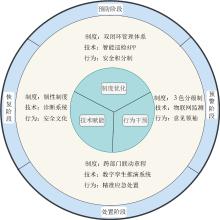| [1] |
国家消防救援局. 2023年上半年全国日均火灾超3000起[EB/OL]. (2023-07-17). https://www.119.gov.cn/qmxfgk/sjtj/2023/38420.shtml.
|
| [2] |
MASOUDVAZIRI N, BARDALES F S, KESKIN O K, et al. Streamlined wildland-urban interface fire tracing (SWUIFT): modeling wildfire spread in communities[J]. Environmental Modelling & Software, 2021, 143: DOI: 10.1016/j.envsoft.2021.105097.
|
| [3] |
ANSARI M H, BIJANI M, ABBASI E, et al. Determinants of local community participation in forest fire management in the northern Iran[J]. International Journal of Disaster Risk Reduction, 2024, 107: DOI: 10.1016/j.ijdrr.2024.104478.
|
| [4] |
STEPHENS K K, POWERS C J, ROBERTSON B W, et al. Building more resilient communities with a wildfire preparedness drill in the US: individual and community influences and communication practices[J]. Journal of Contingencies and Crisis Management, 2023, 31(1):26-38.
|
| [5] |
CVETKOVIĆ V M, DRAGAŠEVIĆ A, PROTIĆ D, et al. Fire safety behavior model for residential buildings: implications for disaster risk reduction[J]. International Journal of Disaster Risk Reduction, 2022, 76:DOI: 10.1016/j.ijdrr.2022.102981.
|
| [6] |
SHOKOUHI M, KHORASANI-ZAVAREH D, REZAPUR-SHAHKOLAI F, et al. Safety concept of fire related injuries in inhabitants of residential buildings in Iran: a qualitative study[J]. Injury, 2020, 51(8):1817-1822.
doi: S0020-1383(20)30438-1
pmid: 32482431
|
| [7] |
MAEZUMI S Y, FLETCHER M-S, SAFFORD H, et al. Fighting with fire: historical ecology and community-based approaches to fire management, stewardship, and ecosystem resilience[J]. One Earth, 2024, 7(6): DOI: 10.1016/j.oneear.2024.05.016.
|
| [8] |
ZIKELOGLOU I, LEKKAS E, LOZIOS S, et al. Community's evacuation planning and response for the 2021-2022 fire seasons in Greece[J]. Safety Science, 2024, 172:DOI: 10.1016/j.ssci.2024.106434.
|
| [9] |
BROWN G D, LARGEY A, MCMULLAN C, et al. Fire safety protection motivation and preparedness in Irish apartments: a Post-Grenfell analysis[J]. Safety Science, 2022, 148:DOI: 10.1016/j.ssci.2021.105630.
|
| [10] |
李梦醒, 王紫微, 周魁斌. 森林城镇交界域内建筑受林火威胁风险的模型构建和应用举例[J]. 林业科学, 2024, 60(11):119-127.
|
| [11] |
韦泽, 李子建, 张培红. 细水雾控制高层住宅烟道火灾的有效性及参数优化[J]. 消防科学与技术, 2022, 41(4):505-509, 519.
|
|
WEI Ze, LI Zijian, ZHANG Peihong. Effectiveness and parameter optimization of water mist control system for exhaust duct fire in high-rise residential[J]. Fire Science and Technology, 2022, 41(4):505-509, 519.
|
| [12] |
刘朝峰, 许强, 齐钦, 等. 高层住宅建筑火灾应急疏散模拟与策略研究[J]. 灾害学, 2022, 37(2):174-181.
|
|
LIU Chaofeng, XU Qiang, QI Qin, et al. Sudy on simulation and strategy of fire emergeney evacuation in high-rise residential building[J]. Joumal of Catastrophology, 2022, 37(2):174-181.
|
| [13] |
武乾, 杨建宏, 徐树文. 基于N-K和SNA的高层住宅火灾事故风险因素分析及控制[J]. 防灾减灾工程学报, 2025, 45(1): 128-136.
|
|
WU Qian, YANG Jianhong, XU Shuwen. Risk factors analysis and control of fire accidents in high-rise residential buildings based on N-K and SNA[J]. Journal of Disaster Prevention and Mitigation Engineering, 2025, 45(1): 128-136.
|
| [14] |
鲁义, 伍江乐, 邵淑珍, 等. 基于贝叶斯网络的危化品道路运输事故推理模型[J]. 中国安全科学学报, 2022, 32(3): 174-182.
doi: 10.16265/j.cnki.issn1003-3033.2022.03.024
|
|
LU Yi, WU Jiangle, SHAO Shuzhen, et al. Prediction model for road transport accidents of hazardous chemicals based on Bayesian network[J]. China Safety Science Journal, 2022, 32(3):174-182.
doi: 10.16265/j.cnki.issn1003-3033.2022.03.024
|
| [15] |
CHANG Yuanjiang, ZHANG Changshuai, WU Xiangfei, et al. A Bayesian network model for risk analysis of deepwater drilling riser fracture failure[J]. Ocean Engineering, 2019, 181:1-12.
doi: 10.1016/j.oceaneng.2019.04.023
|
| [16] |
LIU Zengkai, MA Qiang, CAI Baoping, et al. Risk coupling analysis of subsea blowout accidents based on dynamic Bayesian network and NK model[J]. Reliability Engineering and System Safety, 2022, 218: DOI: 10.1016/j.ress.2021.108160.
|
| [17] |
陈伟, 杨主张, 熊威, 等. 装配式建筑工程施工安全风险传导DEMATEL-BN模型[J]. 中国安全科学学报, 2020, 30(7): 1-6.
doi: 10.16265/j.cnki.issn1003-3033.2020.07.001
|
|
CHEN Wei, YANG Zhuzhang, XIONG Wei, et al. Research on DEMATEL-BN model of construction risk transmission for prefabricated building[J]. China Safety Science Journal, 2020, 30(7):1-6.
doi: 10.16265/j.cnki.issn1003-3033.2020.07.001
|
| [18] |
北京市应急管理局. 大兴区“11·18”重大事故调查报告.[EB/OL]. (2018-06-25). https://yjglj.beijing.gov.cn/art/2018/6/25/art_7466_354.html.
|
| [19] |
国务院北京丰台长峰医院“4·18”火灾事故调查组. 北京丰台长峰医院“4·18”重大火灾事故调查报告[EB/OL]. (2023-10-25). https://www.mem.gov.cn/xw/bndt/202310/t20231025_466750.shtml.
|
| [20] |
国务院河南平顶山“5.25”特别重大火灾事故调查组. 河南平顶山“5·25”特别重大火灾事故调查报告[EB/OL]. (2015-10-14). https://www.mem.gov.cn/gk/sgcc/tbzdsgdcbg/2015/201510/t20151014_245219.shtml.
|
| [21] |
张燕. “瓦片经济”考验城乡接合部人口治理[N]. 第一财经日报,2011-04-27(A4).
|
| [22] |
谢朝阳, 刘卫红, 陈程. 加快建设特种职业信用管理体系:对北京长峰医院火灾事故的再思考[J]. 北方工业大学学报, 2024, 36(6):129-136.
|
|
XIE Zhaoyang, LIU Weihong, CHEN Cheng. Accelerate the establishment of a credit management system for special occupations: rethinking of the fire accident in Beijing Changfeng hospital[J]. Journal of North China University of Technology, 2024, 36(6):129-136.
|
| [23] |
邓李政. 基于事故树方法的养老院火灾事故分析及预防对策[J]. 安全, 2016, 37(9):18-20.
|
| [24] |
佟瑞鹏, 王露露, 许素睿, 等. 本质安全、行为安全、过程安全与功能安全的比较研究:基于安全管理范式转换[J]. 中国安全科学学报, 2025, 35(1):7-15.
doi: 10.16265/j.cnki.issn1003-3033.2025.01.1045
|
|
TONG Ruipeng, WANG Lulu, XU Surui, et al. Comparative study of inherent safety, behavior-based safety, process safety and functional safety based on safety management paradigm shift[J]. China Safety Science Journal, 2025, 35(1): 7-15.
doi: 10.16265/j.cnki.issn1003-3033.2025.01.1045
|
| [25] |
HU Jun, SHU Xueming, SHEN Shifei, et al. A method to improve the determination of ignition probability in buildings based on bayesian network[J]. Fire and Materials, 2022, 46(4): 666-676.
doi: 10.1002/fam.3014
|
| [26] |
KIM H M, WON B K. Big data analysis of the women who score goal sports entertainment program: focusing on text mining and semantic network analysis[J]. The International Journal of Internet, Broadcasting and Communication, 2023, 15(1): 222-230.
|









